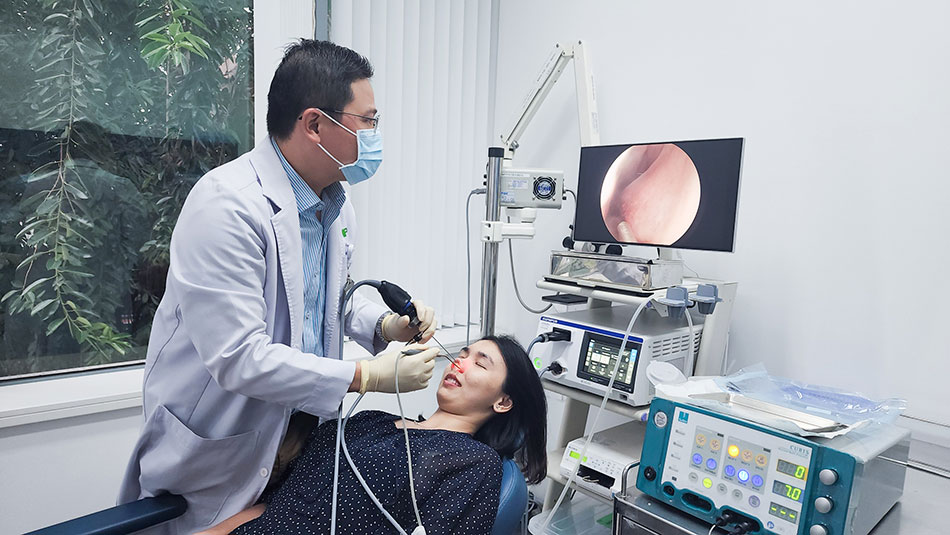Nasal hypertrophy is an overgrowth of the nasolacrimal duct, a structure located inside the nose. The nasal tube is covered by a mucous layer which filters, keeps warm and humidifies the air when we breathe. Normally the mucosa will swell during the physiological cycle of the nose and when we lie down. However, it can also become enlarged in case of a reaction to an allergy or other stimulus.
Symptoms of hypertrophy of the lower nasopharynx include shortness of breath; nasal congestion alternately or on both sides of the nasal cavity; a stuffy nose; a stuffy nose while lying down; snoring or mouth breathing while sleeping; increased secretions. Hypertrophy can lead to dryness of the nasal mucosa, loss of smell, irritation of the nose and itching of the nose.

Causes of hypertrophy of the nose
According to Vo Cong Minh, MD, PhD, Head of FV’s Otolaryngology Department, the cause of hypertrophy of the nasopharynx is usually due to a prolonged inflammatory reaction in the lower nasolacrimal mucosa. The cause of the inflammatory response can be due to allergies, sinusitis, or a cold, among other factors. Irritants present in the environment, such as cigarette smoke and air pollution can also cause irritation that leads to inflammation and nasal hypertrophy. A deviated septum can also cause compensatory oedema of the nasopharynx, resulting in hypertrophy of one nasal passage and obstruction.
Inflammation of the nasopharynx can be treated via various methods, including bending or burning of the nasal coil with a bipolar electric knife, cutting part or all of the lower nasal turbinate, a submucosal resection or endoscopic surgery to cut the lower coil of the mucous membranes, and laser cauterisation. Generally, the above-mentioned methods have undesirable side effects, such as nasal pruritus, post-procedural bleeding, nasal adhesions, olfactory dysfunction, and a reduction or loss of the ability to smell. They can also negatively impact the physiological function of the nose to humidify, filter, and regulate the air temperature before entering the lungs.
Treatment of hypertrophy of the lower nasal turbinate with modern high-frequency waves
Currently, FV’s Otolaryngology Department is one of the few hospitals in Ho Chi Minh City which offers CURIS® technology, which minimises submucosal burning of the lower nasal tuck by utilising high-frequency waves. CURIS® is the latest version of Sutter’s high radiofrequency ablation machine, a minimally invasive product which combines the most advanced technologies to provide a high degree of surgical precision, enable faster healing and ensure patients benefit from a shorter recovery period.
Due to its RaVoR™ volume reduction mode and a specialised nasal coil, doctors can reduce tissue volume accurately and on-target. By using radiofrequency to induce ionising energy injury in the submucosal tissue of the nasopharynx and create scarring, the total tissue volume is reduced with very little impact on the surrounding tissues.
Another benefit of the radiofrequency ablation method when compared with traditional methods is that the procedure is relatively quick and painless, causing less bleeding in the tissue, ergo reduced scabbing. Nasal mucosal function is also better preserved.
Many cases benefit from treatment with high frequency waves

When excessive swelling of the nose causes infection, nasal congestion and many other health problems, the doctor may intervene to burn the lower nasal bridge, specifically, in the following cases:
- Sleep apnoea, when the patient has difficulty wearing a nasal CPAP mask due to nasal obstruction caused by hypertrophy of the nasopharynx
- Nasal congestion due to hypertrophy of the nasal mucosa
- Nasal congestion and excessive rhinorrhoea due to or related to nasal hypertrophy
- Chronic rhinitis unresponsive to medical treatment
- Enlarged nostrils and mucus stasis after rhinoplasty, rhinoplasty, trans nasal endoscopy or septum correction
In addition to its main capability of accurately burning nasal tissue, the CURIS® machine is also used FV Department of Otolaryngology’s to treat many other diseases, such as:
- Bipolar tonsillectomy
- Treatment of snoring by submucosal burning and oropharyngeal orthodontics (RF UPPP), shrinking the bottom of the tongue
- Surgery of the larynx, epiglottis
When visiting FV, patients will be treated by highly qualified, experienced doctors using the most advanced medical equipment available. Everyone at FVH is dedicated to ensuring patients are comfortable at all times and benefits from the best possible outcomes.
To book an appointment at the Otolaryngology Department, FV Hospital, please contact (028) 54 11 34 41 or (028) 35 11 33 33, ext. 7711.



